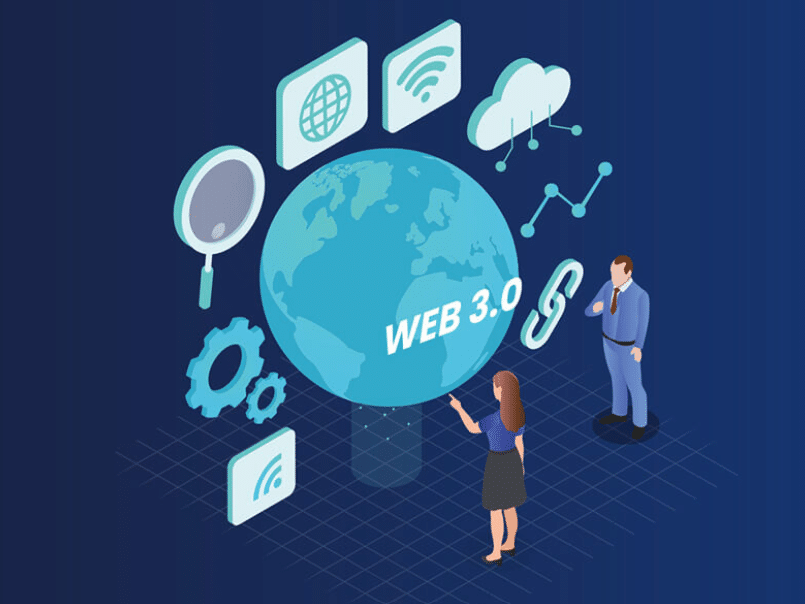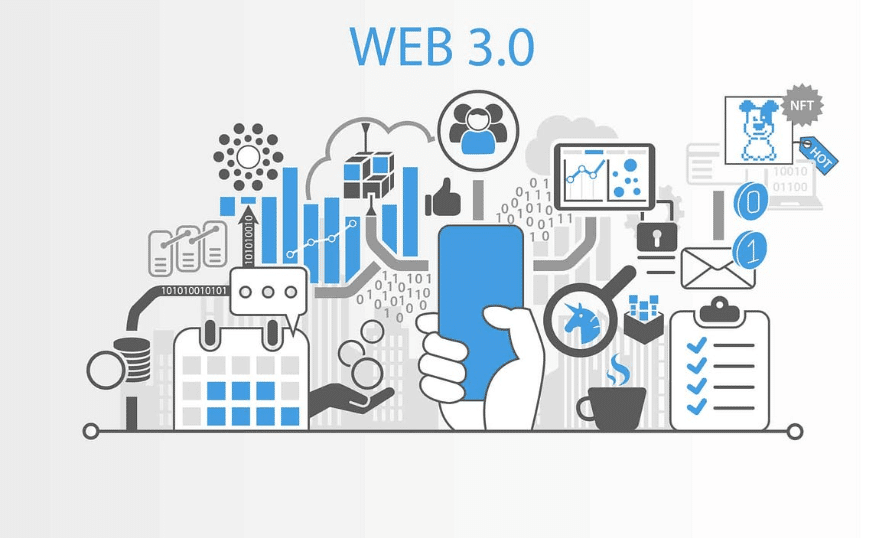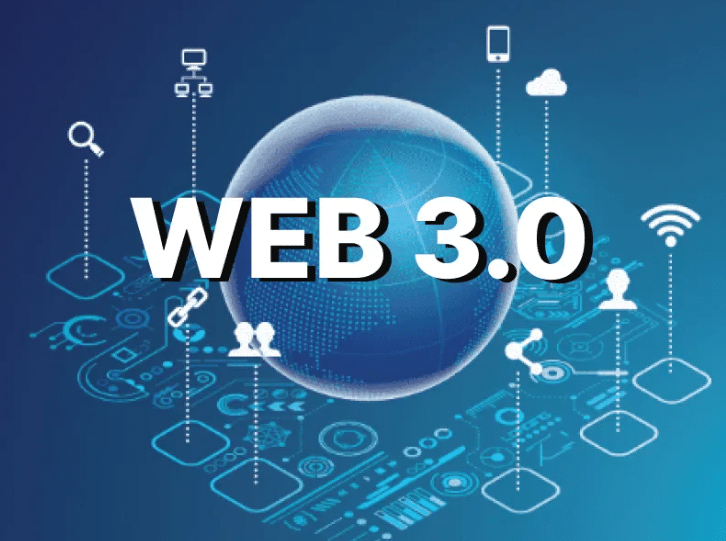Introducing Web 3.0
Web 3.0 is a revolutionary advancement that has helped realize business opportunities in the competitive and unconceding virtual market, particularly for small firms. According to this plan, the Internet’s subsequent phase is decentralized, better for the end users and more secure in terms of the data they share.
For SMEs, going for Web 3.0 is about surviving in the current era and being a step ahead of the competition. In other words, they must apply these new technologies to achieve better and more secure transactions to win customers’ trust and increase operational effectiveness.
It’s enough with blockchain terms, but there are many, all of which will give efficiency and good customer experiences. When we consider what Web 3.0 could do for the small business, you’ll understand and appreciate its possibilities.

Decentralized Innovations
Decentralization stands out as a crucial element of Web 3.0, aiming to spread power more evenly across a network rather than concentrating it in the hands of a few. As part of this change, blockchain-based solutions are used to optimize the process of secure and transparent transactions. This innovation can, therefore, improve people’s trust, which is a major influence on business progression.
Geared toward decentralization and based on blockchain technology, decentralized finance or DeFi is the last key feature of Web 3.0. From the foregoing, DeFi offers small businesses an opportunity to acquire other funding models that do not rely on banking systems. DeFi platforms have the potential to fund businesses with attractive terms, facilitating investment towards company expansion and development.
Web 3.0 also has decentralized applications (dApps) that operate on Distributed Ledger Technology (DLT) and incorporate high-security measures. Such apps can cover almost any business process, starting with the supply chain and ending with client interactions, and they are not dependent on centralized servers. Such decentralization increases productivity in an organizational setting and minimizes data theft and system collapse setbacks.
Therefore, those modern solutions afford small businesses higher reliability, security, and productivity in the long term, which is critical for sustainable development of businesses in the digital realm.
Understanding Smart Contracts
Smart contracts are automated agreements encoded directly into the blockchain. These contracts perform predefined work when conditions are triggered, and no middlemen are required. For small businesses, this means that operations can become enhanced and safeguarded.
For instance, payments can be automatically processed when a shipment is received, or a rental agreement can be renewed without manual intervention. Automating such processes allows business owners to focus on core business and avoid time-draining and possible mistakes. Further, smart contracts reduce the provisions of fraud because all the related information, such as the contract terms or its activity, can be checked by all contributing parties through the blockchain. This can result in more efficient business transactions, creating better business-customer relations.

Improved Customer Engagement
Web 3.0 holds the potential for a new form of customer engagement, with technologies such as AI and machine learning at its core. These tools then aid in analyzing customer information so that small businesses can offer their clients particular experiences. For instance, because of AI, recommendations can be made using previous interactions a customer has had with a company in the product, thus increasing satisfaction and loyalty.
Moreover, self-learning chatbots create more value for clients by promptly addressing customers’ concerns with less escalation to service centers. Besides this, they also increase customer satisfaction and decrease the manpower usage for handling such petty complaints. Rather, their time can be utilized in more strategic business-related tasks.
Other types of extended reality, such as augmented and virtual, are also receiving broad acceptance as they help businesses give customers entertainment experiences. As a result, these technologies help develop attractive and innovative brand experiences essential for small firms to succeed.
Data Control and Privacy
With Web 3.0, businesses can prioritize data privacy in ways that build stronger customer relationships. The new phase of the internet targets at enabling users to have better control and filter the information that they post about themselves on this media. To adapt to this new change, small businesses are forced to go for privacy friendly marketing strategies that are acceptable to the users and customers.
Blockchain solutions can minimize the risk of centralized data storage, as the information will be distributed; therefore, the probability of a breach is low. It also supplies user information and ensures the data authority. Also, businesses can propose to control data traffic and to use the user’s information only if the individual allows it.
However, the themed service delivery poses the strength of individualising privacy space. With progressively evolved technologies like AI and machine learning, anonymized information can be used to offer personalization or services. With the help of it, businesses can create highly individualized goods while at the same time considering constraints put in place by users’ privacy laws.
Therefore, decentralised answers can enhance user authentication and provide clients with more reliable identification procedures without extremism. This, in aspect, enhances the general reliability and trust which is placed in the business or the company.
Consumer rights for their data mean that utilizing and implementing Web 3.0 in small businesses is becoming more significant for building a trusting customer base.

Innovative Revenue Streams
Web 3.0 makes it possible to generate revenues in new ways by introducing concepts like the tokenization of digital assets. Small businesses may tokenize pe tokenize products or services to create localized localizations of property that can be exchanged. Apart from satisfying technophile consumers, it enables the establishment of societies with viral, sustainable markets.
Small businesses can also follow a similar model to the current use of NFTs for production, using them to sell unique items or services, opening up a new market segment, and improving the brand’s value.
Tokenization transforms otherwise non-standardizable-tradeable assets into tradable tokens, thus opening up new forms of investment and funding and improving a company’s cash cycle. Moreover, digital assets can be divided into smaller parts, which creates even more opportunities for those with fewer funds to invest and makes the target customer pool bigger.
NFTs also offer opportunities to produce creations in limited copies or an exclusive club, an additional value function that would help a company stand out from similar ones. It also fires up the diversified sources of revenues and the closer relationship with the customers who have a high appreciation for the exclusivity of products and service innovations.
Through these innovative revenue modes, small businesses can meet the dynamics of new industry trends and, hence, gain recognition from the new generation of digital clients.
Obstacles and Considerations
While Web 3.0 presents exciting opportunities, integrating these technologies has its challenges. Those sectors that are small and established should be willing to incur the costs. Financial and time costs will likely arise so that new systems can be adopted and implemented. The learning process becomes rigorous for new entrants due to a relative unfamiliarity with blockchain and smart contracts.
To overcome these realities, learning and development should be the top priorities for companies and businesses. This means that materials from courses accessible on the Internet, online seminars, and relevant trade shows can be informative and valuable. Also, with the help of proper technology partners or consultants, small businesses can find ways to better understand utilizing without encountering various difficulties.
Safety and a business’s compliance with security standards are also essential to consider. As these technologies are relatively new, the regulatory landscape is still evolving. For the managers to be aware of the legal factors that may be a barrier to the operations, they have to look at the legal environment and understand the existing laws.
Last but not the least is technical support and maintenance, which is extremely important but frequently becomes an issue for many companies, particularly if the companies under discussion do not have any IT specialists on board. These can be solved by outsourcing tech support services; solving them thus assists small businesses realize the potential of Web 3.0 in business development.

Prospects for the Future
One of the promising trends in Web 3.0 is the rise of decentralized organizations. Rich ankle it rises – It stands for Decentralized Autonomous Organization. It is an organization, a blockchain estate operative with codes known as smart contracts, through which decisions are made without necessarily forming an organization. This can allow small firms within the network to form group projects and assemble resource sharing.
Another particular pattern is the emphasis on scaling blockchain networks across chains. Thus, it ensures that the several decentralized systems correspond and improve business administration. For small businesses, this translates to improved organization and the reality that they must incorporate a range of technologies into their operations without worrying about compatibility issues.
Among the transformations that are improving accessibility to Web 3.0 technologies include user experience design. Interfaces are still growing more user friendly; hence, small business firms will be able to adopt these tools into their processes. This makes it easier for other businesses and companies to be able to realize this advantage that comes with Web 3.0.
Likewise, the development of decentralized offers small businesses new opportunities to penetrate the international market with their own products and services. These platforms also offer other features like secure means of carrying out transactions between users and the creation of markets that are differently operational from normal e-business platforms for small business ventures.
Final Thoughts
Web 3.0 offers tools and technology profiles for small businesses. Due to decentralization and smart contracts, different companies can implement different kinds of benefits directed on operations and security. It also discusses how these innovations facilitate the control of the flow of processes and lead to increased trust for customers in transactions due to the characteristics of the technology.
This is where AI and machine learning allow businesses to create buyers’ solutions in exchange for improvement. At the same time, new opportunities can be opened using digital assets and tokenization; sources of additional revenues and investments are created, and the target audience of tech-oriented companies is attracted.
Small businesses must consider the following challenges associated with adopting these technologies: the need to constantly learn, update the company on regulatory measures, and have good IT support are critical measures that will enable the transition to Web 3.0.
DAOs and, most importantly, connectivity between multiple blockchains are expected to shape the future of Web 3.0. Given that, the technology interfaces will continue to become very user–friendly, easing the adoption of these technologies and thereby reducing the barriers to entry for small business players.
These are new modes of engaging international clients, including market area decentralizing of safer P2P transactions. Concerning Web 3.0, small businesses can gain a lot of know-how about market tendencies and further advance this market sphere. Starting it now provides your business with great chances of being successful tomorrow.

